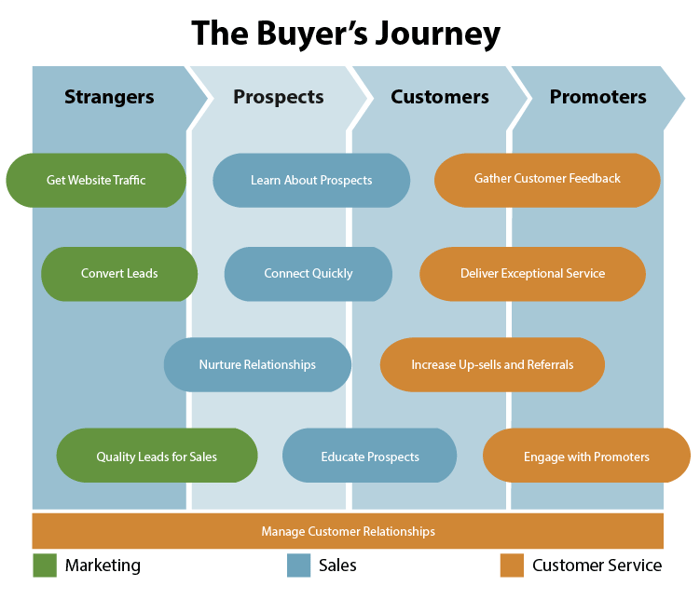

B2B Customer-Facing Role Must Support Business Development
A client-facing team (CFT) includes anyone in your organization who has some level of interaction with your clients and prospects. In most organizations the team spans departments: marketing, inside sales, outsides sales, customer service, and depending on your internal structure, quoting.
To make the greatest impact and leave the least room for error, your CFT must be well-orchestrated and tightly connected – in other words, they must be aligned with each other.
Does alignment really matter in practice? Think about some recent buying experiences you’ve had – both good and not so good. You can almost always tell when client-facing staff isn’t in sync, from an unstaffed service desk to missing documents, to a general sense that the departments don’t know what each other is doing.
In contrast, a well-aligned team is successful because it excels at things like:
- quick, easy, and productive problem resolution
- providing knowledgeable responses
- a friendly disposition
- showing understanding
- routine follow up
If your goal is to acquire and retain clients, your CFT must develop these behaviors and attitudes. After all, this is your “A-Team.” Getting them coordinated and working together is the key to your success. In other words, you guessed it, you need ALIGNMENT. Here’s how.
Plan and define your client-facing team
The first step is to understand who in your organization needs to interact with clients and prospects, why, and what their specific roles are to that end. It can vary from company to company, but these roles are pretty standard starting points:
- Marketing staff engages and nurtures new and existing clients with educational information about how your products and services can provide a solution.
- Sales reps, inside and outside, build a more personal relationship through meetings and calls, as well as face-to-face discussion, listening, and education.
- Customer service reps ensure clients stay delighted with your business through solid follow-up and continued support. They may also play a role in discovering upsell opportunities.
- Quoting staff, for most manufacturers, focus on providing pricing and delivery information; however, these staff often have deep knowledge about specific projects and requirements.
How does your client-facing team work together?
These questions will get you thinking about if and how your CFT works together. Your answers will show what you need to think about to get your team aligned.
- Does each team member have clear roles and deliverables?
- Are our lead generation KPIs assigned to marketing?
- How is a marketing lead defined?
- How is a sales-ready lead defined?
- How do the inside sales staff and customer service measure success?
- Do all team members know how to transfer information and context when a prospect or customer advances to a new stage?
- How will marketing notify sales of a lead?
- In which circumstances will insides sales get outside sales involved?
- If a quote is required, who on the team is notified? How?
- Who follows up on quotes? When? How?
- When does customer service have to reengage sales if there is an issue?
- Are all team members aware of processes and their roles/responsibilities within them?
- Do you have ongoing training to update the team?
- Do you use software that may require updates?
As you plan how the CFT will work together, think about the details of how tasks will be carried out and how information should flow. For example, what’s the timeframe for a follow-up? Is it by email or phone call? Are leads transferred by email, in person, or by automatic notification in your CRM?
It’s proactive to anticipate bottlenecks or points of confusion too. Plan for a range of circumstances so interactions will flow smoothly and there is a backup plan for unusual or complex situations.
As in manufacturing production, a clearly defined process is important. But unlike manufacturing, where once it’s designed the process stays the same until a new product is designed, in marketing and sales, processes rarely stay the same in the long term. CFTs must adapt to change: new issues arise weekly, new questions daily, new competition yearly. As a result, continuous improvement and change are inevitable.
Long-term success only happens when the CFT is ALIGNED. Team members must know what each other does and how roles and responsibilities change so they can continue to work together effectively. It’s not enough to align the team and walk away – they also must continue to stay aware and adapt processes to maintain that alignment and stay effective.
The “place of truth”: one shared platform
In many cases, organizations create a variety of spreadsheets, task lists, process documents, checklists, software, and more. The goal is to track and direct the activities of the CFT, but if each item is not used and maintained, the opposite happens. Staff are confused about responsibilities and procedures, reporting is inaccurate, and work is inefficient. Shifting to a single tool the whole team can access is essential to creating and maintaining alignment.
In the graphic below, marketing activity is green, sales are blue, and customer service is orange. It’s clear how a single, shared platform helps the CFT make it easy for your clients to move through the funnel.

If each team member understands their role and has access to ONE shared sales and marketing platform, you’ll create a single point of truth to help the team stay in alignment. This is especially important because, as we’ve noted, things will change over time. The whole team benefits from unified:
- organizing, segmenting and updating contact information
- understanding and sharing of client needs and pain points
- automation of many manual tasks
- reporting and metrics on all KPIs
- data for analysis and continuous improvement
Simply put, having a single platform gives you the HOLY GRAIL of sales and marketing: the clarity that drives revenue.
As a manufacturer, you would never allow a machine that went offline to sit idle without a plan to get it back up and running. Yet it happens all the time in sales because there is no simple way to diagnose the problem. Using one unified platform you can see real data in real-time, which points the way to a repair. And that one point of truth enables you to discover and address issues quickly. You really can get your sales machine back online – we can help.

